#Vanka Murals
Text
Why You Should Visit Pittsburgh in 2020
Why You Should Visit Pittsburgh in 2020
Pittsburgh, the city of champions, the city of bridges, the city that has completely reinvented itself following the collapse of the steel industry in the 1980s. Unlike other American cities located in the country’s Rust Belt that, as the name suggests, have “rusted away”, Pittsburgh has not only bounced back, it has thrived.Thrived in the form of its restaurant scene, the amount of visitors…
View On WordPress
1 note
·
View note
Text
Historic Pittsburgh murals refreshed with new art, virtual reality, and more | Visual Art | Pittsburgh
Historic Pittsburgh murals refreshed with new art, virtual reality, and more | Visual Art | Pittsburgh
click to enlarge
Photo: Rob Long-Clear Story
“Mary, Queen of Croatia” by Maxo Vanka
Croatian-American muralist Maksimilijan “Maxo” Vanka used the walls of St. Nicholas Croatian Catholic Church as a canvas, forever making the Millvale space a place of both worship and artistic inspiration. The unusual location, while stunning, also makes it challenging to draw audiences in to appreciate the 25…

View On WordPress
#art#fundraiser#Maxo Vanka#Millvale#mural#Paint the Town#Pittsburgh#St. Nicholas Croatian Catholic Church
0 notes
Text
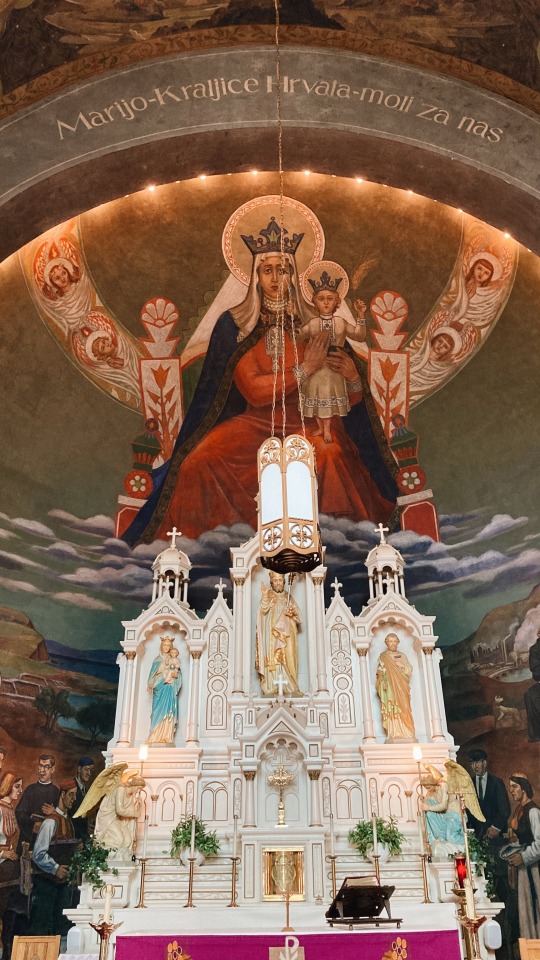
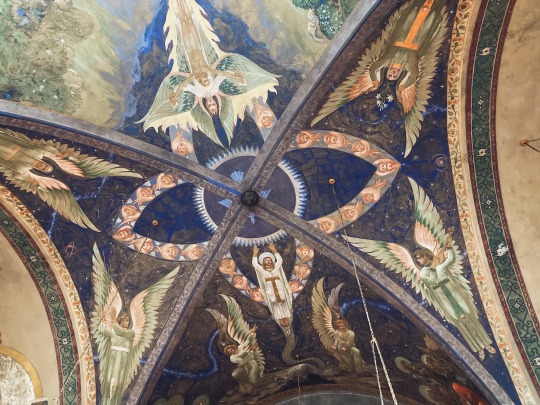


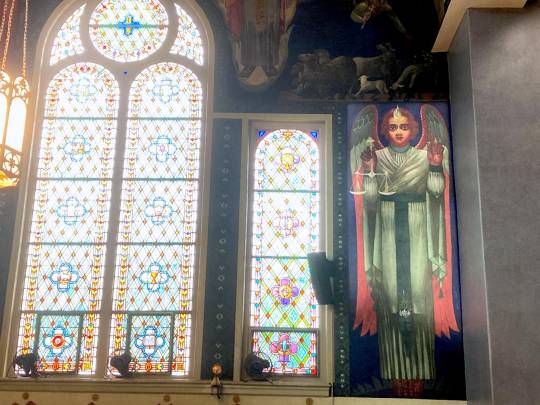

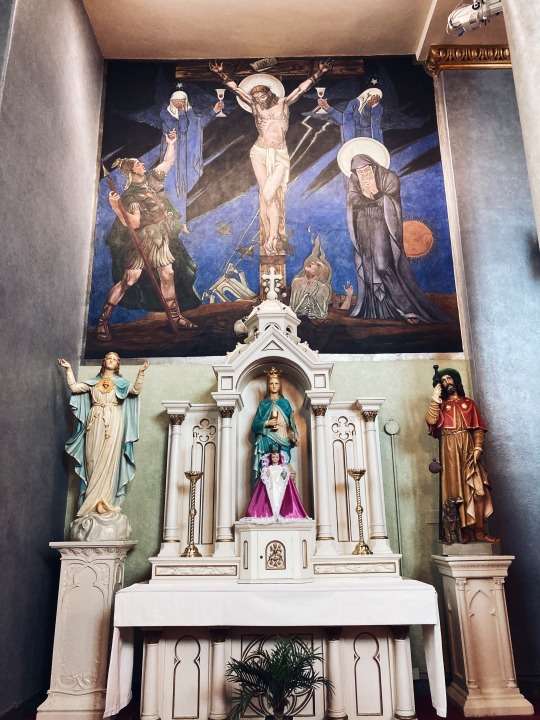

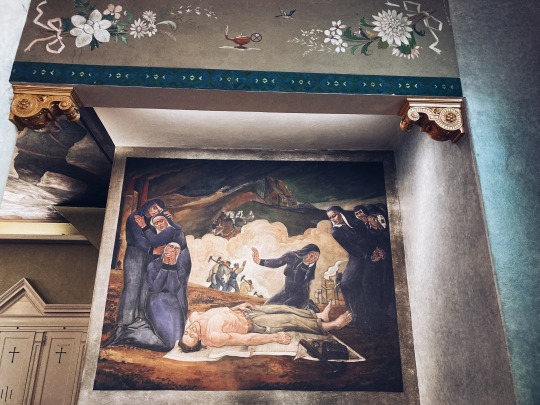
For over a month I have failed miserably to post anything here, proving once again that I can't have good habits. Or at least not yet. Here is something interesting that mostly speaks for itself: a gallery of photographs I took inside Saint Nicholas Croatian Catholic Church in Millave, Pennsylvania (not exactly Pittsburgh, but part of the Diocese of Pittsburgh). These murals were commissioned to Maxo Vanka, a Croatian immigrant artist, in the 1930s. Vanka was the son of aristocrats, though he was born out of wedlock and placed in a peasant home until one of his grandparents found out that he existed and paid for his education in Zagreb. Vanka met Margaret Stetten, a wealthy Jewish New Yorker, while she was doing a tour of Europe; they married and moved back to the US in 1935, as antisemitic sentiment rose. Vanka tried to rebuild his fine arts career and eventually showed work in Pittsburgh, where he caught the eye of the priest of Saint Nicholas. An urban legend (told to me by the friend who took me to this place) says the priest actually dreamt that God ordered to ask Vanka to paint the inside of the church, which was totally white then.
Vanka painted these murals in eight weeks in 1937, which is almost unbelievable. Someone in our guided tour said he was drinking a lot of Coca Cola (apparently it was basically cocaine back then). He returned in 1940 to do the "evil capitalist" one and a couple of others I couldn't photograph very well. The first mural he did was the peasant Virgin Mary, with her broad shoulders and strong hands. Below her Vanka painted two groups: on the left, Croatians in the home country, an idyllic landscape, and dressed in traditional attire; on the right, Croatian immigrants, many of them wearing their work clothes and tools, and one of them holding a miniature model of St. Nicholas itself––a gift of the community to the Virgin. One of the other murals depicts the Crucifixion, and there are portraits of the apostles in the upper walls and ceiling. The vibrant color palette (the royal blue!) and the elongated, expressionist faces and bodies are probably the most immediately arresting elements that stay consistent throughout all the scenes. However, the main attraction here are the anti-war and anti-exploitation murals in which groups of women mourn a fallen soldier in Croatia and a fallen miner in Pittsburgh ("Mothers offer up their sons for war" and "Mothers offer up their sons for labor"). In the first, several women in traditional white funerary dress surround the casket of a dead soldier. In the second, inspired by real events in Pittsburgh, women dressed in black surround the half-naked body of a man––ostensibly the son of one of them––who has died in a mining accident; in the distance we see other workers heading back into the mine to look for survivors. In another wall, a Rockefeller-like figure sits having dinner while ignoring a beggar at the foot of his table. An angel turns their head away in disgust, and a demon extends a bony hand into the scene.
Within the line of sight of churchgoers, so colorful and cinematic, these scenes become part of the wider experience of prayer or worship. I don't recall seeing something like this before. Some scenes (like the evil capitalist with the top hat and the monocle) maybe feel a bit too on-the-nose, but I suppose that's appropriate for the context. In contrast, a couple of these paintings are hermetic in a way that makes you stare. The Angel of Justice, for instance, which is not really "an angel" that we know of by any name (and which mirrors an Angel of Prudence on the wall across, an emblem I love). The ceiling was my favorite parts of the church, painted like literal heaven, in a beautiful blue with lighter patches, stars, and planets. It seems that some of the lighter blues or greenish patches were caused by water damage (because Pittsburgh gets hurricanes, believe it or not), but they actually look beautiful, like nebulae. On the opposite side of Justice is Injustice (again, very didactic), a strangely futuristic-medieval figure wearing a beaked gas mask.
Not a whole lot is known about Vanka's politics, as far as I've been able to search. He's often described simply as a "pacifist." But, of course, these murals clearly express how war disproportionately affects any working class. The tour guide in the church was also unable to tell us if Vanka had had any contact with Mexican muralists, but the timing is perfect and him being in New York for any period of time would make it likely. While these images most likely follow Eastern European mural traditions, to me they have undeniable echoes of José Clemente Orozco --so maybe it was the spirit of the times.
5 notes
·
View notes
Link
A talk I gave on early 20th century women singers from Turkey, Egypt, & Greece for the Vanka Mural Table Talk series in Pittsburgh with Rich Pell giving an introduction (a blessing on his head) has been posted on YouTube.
9 notes
·
View notes
Text










My Nana took us to see the Vanka Murals at St Nicholas Croatian Catholic Church in Millvale, which is near Pittsburgh.
0 notes
Text
Phantom Priest of St. Nicholas Church in Millvale
In the town of Millvale, stands a stone church built at the turn of the last century. St. Nicholas Church is perched on a bluff overlooking the Allegheny River, an imposing sight to behold and a tribute to the faith of the Eastern European Catholics who built it.
The design of its interior is no less stunning than that of its exterior. The impressive frescoes were painted by the renowned Croatian exile Maxmilian Vanka, a professor of painting in Zagreb who emigrated to the United States in the 1930s. They feature a mixture of social and religious imagery: Near depictions of the stations of the cross are what Vanka saw as modern-day demons-capitalists, stockbrokers, and invading soldiers. The frescoes are a true product of their time, when an improvished Europe was being ravaged by war, spawning art like Picasso’s Guernica, which depicts its horrors.
While Vanka was painting in St. Nicholas, his friend Louis Adamic wrote about some of Vanka’s experiences in his autobiography My America, which was excerpted in the April 1938 issue of Harper’s magazine. The experiences include nightly visitations from a ghost priest.
On Vanka’s fourth night at work, painting above the altar, the dogs outside the rectory began a feverish bout of yelping and barking. Shortly afterward Vanka glanced at the altar beneath him, which was fully illuminated, and saw a figure, a man in black, moving this way and that, raising his arms and making gestures in the air.
Vanka assumed that it was Father Zagar, who had commissioned the mural, practicing his religious duties in the still of the night. But during one of the Vanka’s nightly chats with Zagar at the rectory, he got a strange response when he brought up the encounter. Zagar looked at him for a long time, then finally said, “That was not me.” This abruptly ended their conversation.
Four nights later Vanka felt a strange chill creep over him, and again he looked down to see the phantom priest dressed in black, with his arms outstretched, as silent as the grave but with hips lips moving and his arms gesturing in a very animated fashion. Vanka continued to paint, but when slowly footsteps and murmuring broke the silence, he looked down again. The figure was moving slowly down the aisle toward him. Vanka worked on until the apparition walked right up to the scolded and quietly extinguished the lights. With only a dim lantern to guide him. Vanka beat a hasty retreat to the rectory and woke up Father Zagar.
This time, Vanka demanded an explanation. In Adamic’s account, the priest gave a doozy:
People began to whisper of the ghost in this church fifteen years ago. . . . I have never had any experience with it, but there are others, many others, who say they have. Years before I came here, there were fights among the Croatians about this ghost, spirit, whatever it is. I have always been skeptical about such things, but . . . there are times when I feel that maybe there are some phenomena we might not understand.
Zagar went on to explain that he had be hiding in the church and watching Vanka at work since the painter had first mentioned the mysterious priest. That evening, he had succumbed to sleep and unable to watch over the artist, and sure enough, the apparition had shown itself. So the following night, Zagar decided to keep Vanka company while he worked.
Things were quite convivial until a series of loud echoing knocks filled the church, followed by the baying of the dogs outside. Vanka was chilled to the bone as he saw the man in black standing at the fourth pew, much more clearly visible this time than ever before. His face was tinged with blue, very old and bony, and wearing an expression of misery. The specter vanished before Father Zagar could catch a glimpse, but he felt the presence very clearly. During the remaining months of Vanka’s assignment, he continued to hear and see the ghostly priest, his visits accompanied by sudden drops in temperature, filling Vanka with terror. Father Zagar continued to pray for the relief of the poor phantom’s spirit. When the work was finally finished, Vanka moved to the other side of the state, where he lived out the rest of his days.
When talking with his friend Adamic about his experience, Vanka described the phantom as being “perfectly mild, pensive-like, sitting in the pews or moving up and down the aisle; yet he filled me with indescribable horror, with something higher and stronger than fear.” When Adamic’s memoir was published, the ghost stole Vanka’s thunder too-for decades, the tale of the phantom priest was more famous than the masterpiece, Vanka had painted while being haunted by him. Thankfully, the artist’s work has enjoyed renewed interest, with permanent exhibitions at the Doylestown Michener Museum, and of course, the magnificent frescoes at St. Nicholas still exist. But if you visit the church, don’t mention the phantom priest. In private moments, the living priests may admit to having seen him, but they have tired of the relentless publicity that Adamic’s Harper’s article had stirred up nearly seventy years ago.
0 notes
Photo

Millvale’s History
Millvale has a lot of significant stories and historically important landmarks spread across the borough. A current resident of Millvale had a few stories to share over a drink when I visited Millvale over the weekend –
The mound, which is also called as a “the Berm”, which holds the PA 28 state highway at the entrance of Millvale used to be the location of the Mill, which gives the borough its name. Most of its workers settled in and around Millvale, which gave it a unique cultural setting brought by it’s residents.
The tracks of the railroad or the street car that used to serve the factory are still visible in a parking lot next to the Berm as one gets off the PA 28 and enters Millvale.
Perched on a hill, just across the parking lot, one can see the church of St. Nicholas which holds one of kind masterpiece murals by Croatian artist Maxo Vanka.
Apparently, Millvale was never supposed to exist as it lies completely in a flood plain and all the water run offs from the near by hills flow into Millvale resulting in floods. But due to the mill and the will of it’s residents, the community continues to thrive irrespective of the floods.
Millvale has a natural swale called Girty’s run which collects most of the storm water run offs and flows into the river on the east. This swale was culverted to create two main streets – Grant Ave and Lincoln Ave to connect it to water’s edge.
Lastly, Millvale is home to many cultural and social icons like the Millvale Moose, Mr. Small’s theatre, The gardens of Millvale, numerous craft breweries, restaurants and cafes.
1 note
·
View note
Text
Pitt Stops - Maxo Vanka Murals
Pittsburgh vast culture expands beyond that of the city limits. If you ever find yourself on the other side of the Allegheny river in a place called Millvale, there’s a hidden gem of the art world at the St. Nicholas Croatian Catholic Church. Maxo Vanka, a croatian painter had completely layered the interior with 25 beautiful murals of christ and catholicism throughout the mid 20th century. Vanka completed these murals in 1937 and 1941 in two stints in America, and his art reflects the turmoil of the age. The murals often depicted men and women in clothing of the age, although the most prominent focal point is how Vanka includes the conflict of WWII into his sprawling artistic magnum opus. He depicts the virgin Mary as a strong and powerful matriarch. The angel Injustice appears in a gas mask, judging the soldiers of the second great war. Nuns lament the death of a miner due to the harsh work environment of the age, in a time where progress waits for no one.




The St. Nicholas Catholic Church was not always intended to house such lively pieces. Vanka took on the project after the church’s total reconstruction after a fire destroyed the structure shortly before his works would inhabit it. Being the first Croatian Catholic parish in America meant that it was a hub for the small Croatian community at the time, and Vanka only served to enrich that community with his works.
0 notes
Text
“Do Good Friday” *Work from Home*
Two. Weeks. Left.
This week was crazy busy with schoolwork, finals are coming quickly. But I still enjoy doing my intern work for Blender. They have been so kind to me and I’m so grateful I got the chance to learn and grow in such a supportive environment.
This week Abby was on vacation in Florida so I worked with Chris and Katy on a variety of projects. Our generous boss, Kris gave us Friday off and called it “Do Good Friday” which I thought was very thoughtful. But I did work anyway because I have to hit that 200-hour mark!
I did a media scan of all the press coverage of the Millvale murals of Maxo Vanka for a new client. I drafted social posts for #StrongMomStrongBaby to promote an event hosted by the Alexis D’Achille Foundation. I wrote Facebook and Twitter posts promoting Point Park Connections, which I have friends performing in, that was a fun full-circle moment. I also did some research and found articles for #StrongMomStrongBaby and #FamilyFirstPA.
It is so rewarding to do work that I feel great about. Helping nonprofits and social campaigns get off the ground is definitely something I could do in my future career.
0 notes
Photo





I had a very good weekend that ended with a mega cold and gnarly weather. Maxo vanka murals are stunning, Jean Marc still has the best pastries, and Pamela's is where I finally tried trappeys red devil on eggs. Praying for a blizzard tomorrow so I can lay in bed all day with my cats.
0 notes
Link
Have You Any News From Home?: Immigrant Women Singers From Turkey, Egypt, and Greece on Early 20th Century Recordings
Tuesday, April 27th @ 6:30PM (ZOOM Webinar)
Music researcher Ian Nagoski describes the life and work of five artists during and after the peak years of U.S. immigration in parallel with the rise of the commercial sound recording business. They departed their homes by steam ship during the disintegration of the Ottoman Empire and lived through two world wars, famines, massacres, and political turmoil at a distance from within the Golden Door of America. Through it all, these performers’ little-known lives illuminate the changing status of immigrants in the U.S. during those years and how creative people expressed their connections to their communities, their own aspirations, and all-too-human ways of coping and enjoying themselves.
Panelists:
Presented by: Ian Nagoski, music researcher and record producer
Host: Richard Pell, Director, Center for PostNatural History
The program is free but registration is required. Donations to support the Vanka Murals mission including this program are greatly appreciated and may be added to your registration.
3 notes
·
View notes
Link
a talk I gave February 14, 2020 St. Nicholas Croatian Church (Home of the Maxo Vanka murals) in Pittsburgh, PA. A few little factual errors. A lot left out that I should have said, particularly naming Harry Kezelian and Harout Arakelian for their work on the Panosian story. What's edited out is an audience member at the beginning telling me to speak more slowly, which is the cause of my having left out a lot of important stuff.
2 notes
·
View notes